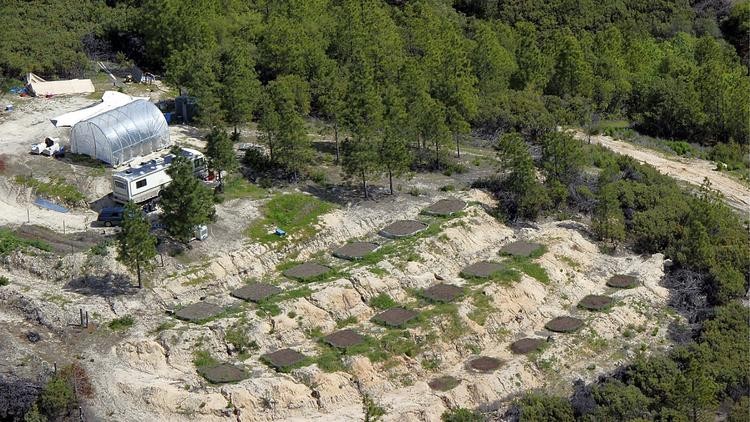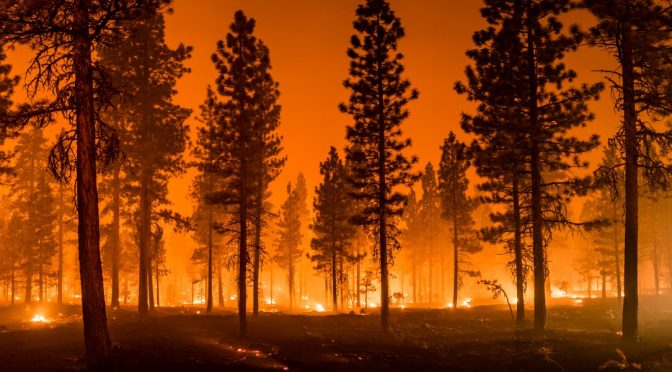For thousands of miles along the west coast, skies are red, orange, or gray with the dust of ash. It’s apocalyptic. People are losing their homes and more than a few people have died in the three states which bookend our west coast. Watching these catastrophic flames begs the answer to a new question. How much global warming and climate change could have been avoided if California, Washington and Oregon hadn’t legalized pot?
The track of west coast fires follows the trail of growth in the massive marijuana industry over 25 years. It began north of San Francisco, moved further south along the central coast of California and up into Oregon and Washington. Washington, which made pot legal in 2012, hit a historical moment with more than 330,000 acres burning in 24 hours, more than in the entire fire seasons of 12 out of the last 18 years. Not until the last few years has Oregon, which legalized marijuana in 2015, been a large part of the fire problem. Oregon has a huge surplus of marijuana.
At the moment, four cities on the “West Coast of Weed” have the world’s worst air quality.
Many politicians advocate for “a green new deal,” but they present the ideas too quickly, with solutions not thought out well enough to work. Only bipartisan solutions will work, and then only when the public accepts and understands the issue, and all facets of climate change — including marijuana.

Being “green” on marijuana destroys environmental “green”
How ironic that politicians in Washington, Oregon and California care about global warming, but support one of nation’s biggest environmental disasters–the marijuana industry. They complain only about fossil fuels while publicly endorsing this earth-scarring industry. It’s possible that the marijuana industry fuels global warming more than strip mining, fracking, agriculture or any other industry.
Also the growers use pesticides and rodenticides which kill animals and threaten the eradication of species. And when it comes to the droughts, blame pot not almonds for California’s water woes.
Replacing the logging industry with the marijuana industry
Throughout the 80s and 90s, environmentalists fought the logging industry in Humboldt County, California, home of giant redwoods and sequoias. In 1995, they won a landmark suit against Pacific Lumber Company, and the company went bankrupt 8 years later. Its assets were sold to Humboldt Redwood Company which promised to log sustainably. The logging industry barely exists in the Emerald Triangle, three California counties known for marijuana. Once the backbone of this area, logging is slowly dying in the Pacific Northwest.
The marijuana industry moved in and cleared giant trees as quickly as loggers left. Marijuana enthusiasts, emboldened by California’s vote in 1996 vote to allow marijuana as medicine, moved into the forests to grow pot in bulk. Hiding between the giant trees, many of these illegal growers went unnoticed until satellite photos led to their discovery. In 2010, a ballot to legalize marijuana for recreational purposes in California, led to an even greater increase in the desecration of forests to grow marijuana. (That ballot did not pass, but environmental damage grew when entrepreneurs hoped for and prepared for an expanded marijuana market.)
Because the huge, ancient trees sequester carbon and trap water, those concerned about climate change were justified to worry about the destructive practices of Pacific Lumber. Giant redwoods absorb water into their leaves directly from the abundant fogs of California’s north coast. On other the hand, 15-foot marijuana plants need at least five gallons of water everyday. Marijuana growers divert streams for irrigation, killing what was once an abundant, natural fish supply. Furthermore growers use banned pesticides which flow into the watershed, killing the rich ecosystem.
Aerial views show the redwood forests pockmarked by marijuana grows. Only one of the major progressive publications, Mother Jones, wrote about the irony that marijuana green is not environmentally green.
See the video about the ecological damage from illicit marijuana grows
Underground marijuana farming existed in this region since the 1960s and 70s. The hippies who started it did not bring the problems because they grew for themselves, rather than selling it as “medical” and for the rest of the country.
What if California hadn’t allowed free reign of the marijuana industry after it passed medical marijuana in 1996?
Warnings about global warning were clear but California ignored
By about 2012, the Emerald Triangle supplied about 60% of our nation’s pot, 70% by 2015. A policeman from the Emerald Triangle wrote to PopPot.org before legalization: “I see firsthand how marijuana is a social and environmental disaster — youth access, abuse, transient population moving in to grow or trim, associated criminal behavior — all rising.”
When the state finally started to regulate medical pot, they ignored an effort to add taxes for environmental and enforcement costs. Some people honestly thought the environmental damage could be stopped by legalizing marijuana to “regulate” the offenders. The state failed with medical marijuana, so there wasn’t reason to believe California would learn to regulate “recreational” marijuana.
The Los Angeles Times editorial board warned in 2015: “Any effort to legalize marijuana must ensure that this billion-dollar industry repairs the legacy of damage and becomes a responsible steward of the land.”
California legalized marijuana by ballot in 2016, because of a multi-million dollar advertising campaign. Billionaires and the cannabis industry funded the ballot. Despite legalization, California’s black market dealers outsell the state-regulated pot shops by about four to one. State and county governments still work to eradicate the illegal growers, who avoid paying state’s taxes and fees. The state issues large fines for water violations, but cannabis cultivators continue to break all the rules. It’s hard to conceive of any other domestic policy that has failed so completely.
Global warming and other environmental problems
In May of 2008, approximately 1000 of gallons of red diesel overflowed from an indoor marijuana grower’s fuel room into a creek. The marijuana grower had left a valve open when pouring a larger diesel tank into a smaller one. The fuel had spread so far down the rugged stream bed when a neighbor smelled the pungent odor and investigated. He found “20 to 30 pools of red diesel” far below the spill. The environmental cleanup was a massive operation, one of California’s largest; damage from from this one diesel spill rivals the impact of an oil spill in the ocean.
Even before legalization, the marijuana growers polluted the streams and dried up so many river beds. The politicians and the public should have done their homework before they voted to legalize pot.
Please read these other articles from around the web.
- The Landscape-Scarring, Energy-Sucking, Wildlife-Killing Reality of … ›
- 24 mind-blowing facts about marijuana production in the America
- Marijuana Crops in California Threaten Forests and Wildlife – The … ›
- Pot growers endangering California watersheds and wildlife – LA … ›
- Illegal pot farms are poisoning California’s forests
- Mourad Gabriel’s TED Talk
- Energy use on indoor marijuana grows
The logical conclusion is that logging started the destruction of an incredibly rich ecosystem, but the marijuana industry sealed its fate. It’s hypocrisy to support legislation that legalizes marijuana or favors the marijuana industry, while claiming concern about global warming. Now is the time for the two major political parties to work together and find a resolution. California admitted that it failed at regulation.

